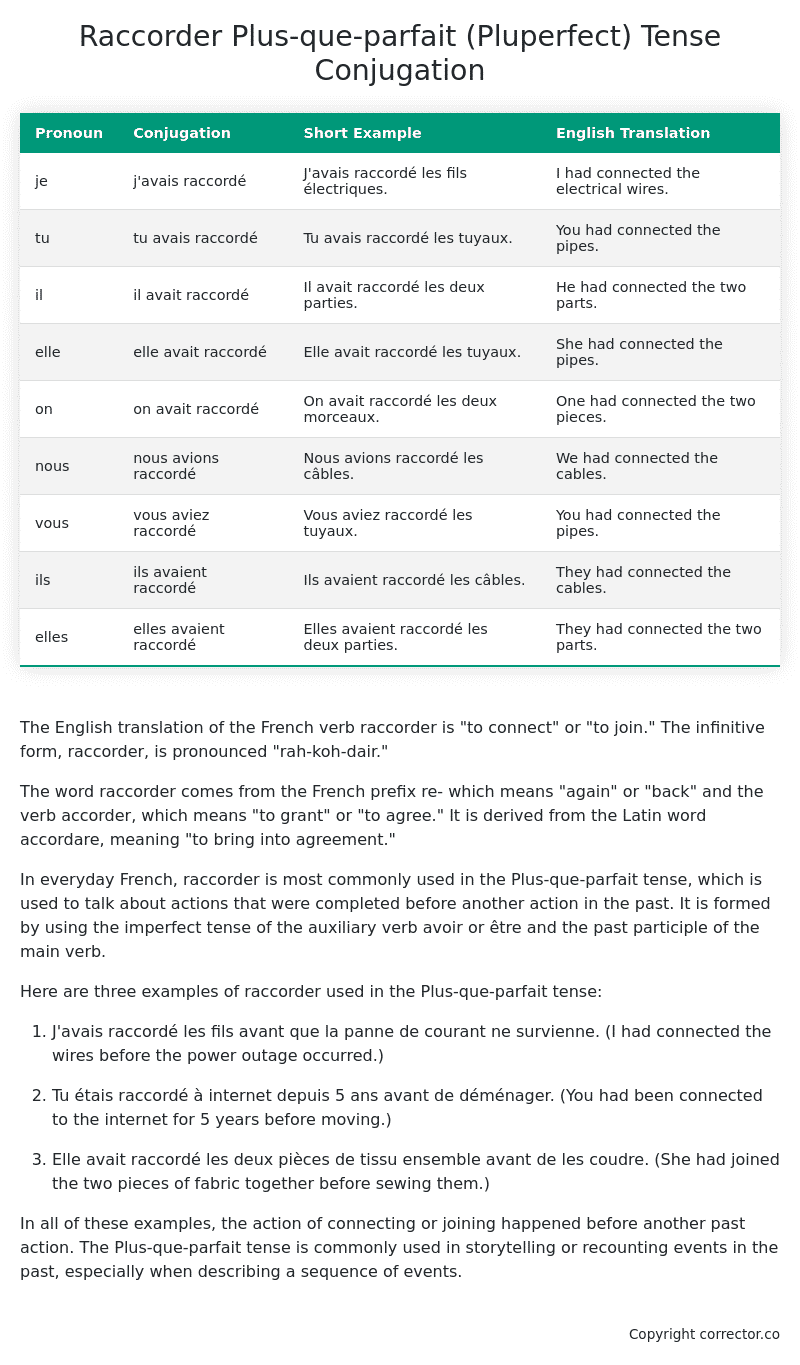Plus-que-parfait (Pluperfect) Tense Conjugation of the French Verb raccorder
Introduction to the verb raccorder
The English translation of the French verb raccorder is “to connect” or “to join.” The infinitive form, raccorder, is pronounced “rah-koh-dair.”
The word raccorder comes from the French prefix re- which means “again” or “back” and the verb accorder, which means “to grant” or “to agree.” It is derived from the Latin word accordare, meaning “to bring into agreement.”
In everyday French, raccorder is most commonly used in the Plus-que-parfait tense, which is used to talk about actions that were completed before another action in the past. It is formed by using the imperfect tense of the auxiliary verb avoir or être and the past participle of the main verb.
Here are three examples of raccorder used in the Plus-que-parfait tense:
-
J’avais raccordé les fils avant que la panne de courant ne survienne. (I had connected the wires before the power outage occurred.)
-
Tu étais raccordé à internet depuis 5 ans avant de déménager. (You had been connected to the internet for 5 years before moving.)
-
Elle avait raccordé les deux pièces de tissu ensemble avant de les coudre. (She had joined the two pieces of fabric together before sewing them.)
In all of these examples, the action of connecting or joining happened before another past action. The Plus-que-parfait tense is commonly used in storytelling or recounting events in the past, especially when describing a sequence of events.
Table of the Plus-que-parfait (Pluperfect) Tense Conjugation of raccorder
| Pronoun | Conjugation | Short Example | English Translation |
|---|---|---|---|
| je | j’avais raccordé | J’avais raccordé les fils électriques. | I had connected the electrical wires. |
| tu | tu avais raccordé | Tu avais raccordé les tuyaux. | You had connected the pipes. |
| il | il avait raccordé | Il avait raccordé les deux parties. | He had connected the two parts. |
| elle | elle avait raccordé | Elle avait raccordé les tuyaux. | She had connected the pipes. |
| on | on avait raccordé | On avait raccordé les deux morceaux. | One had connected the two pieces. |
| nous | nous avions raccordé | Nous avions raccordé les câbles. | We had connected the cables. |
| vous | vous aviez raccordé | Vous aviez raccordé les tuyaux. | You had connected the pipes. |
| ils | ils avaient raccordé | Ils avaient raccordé les câbles. | They had connected the cables. |
| elles | elles avaient raccordé | Elles avaient raccordé les deux parties. | They had connected the two parts. |
Other Conjugations for Raccorder.
Le Present (Present Tense) Conjugation of the French Verb raccorder
Imparfait (Imperfect) Tense Conjugation of the French Verb raccorder
Passé Simple (Simple Past) Tense Conjugation of the French Verb raccorder
Passé Composé (Present Perfect) Tense Conjugation of the French Verb raccorder
Futur Simple (Simple Future) Tense Conjugation of the French Verb raccorder
Futur Proche (Near Future) Tense Conjugation of the French Verb raccorder
Plus-que-parfait (Pluperfect) Tense Conjugation of the French Verb raccorder (this article)
Passé Antérieur (Past Anterior) Tense Conjugation of the French Verb raccorder
Futur Antérieur (Future Anterior) Tense Conjugation of the French Verb raccorder
Subjonctif Présent (Subjunctive Present) Tense Conjugation of the French Verb raccorder
Subjonctif Passé (Subjunctive Past) Tense Conjugation of the French Verb raccorder
Subjonctif Imparfait (Subjunctive Imperfect) Tense Conjugation of the French Verb raccorder
Subjonctif Plus-que-parfait (Subjunctive Pluperfect) Tense Conjugation of the French Verb raccorder
Conditionnel Présent (Conditional Present) Tense Conjugation of the French Verb raccorder
Conditionnel Passé (Conditional Past) Tense Conjugation of the French Verb raccorder
L’impératif Présent (Imperative Present) Tense Conjugation of the French Verb raccorder
L’infinitif Présent (Infinitive Present) Tense Conjugation of the French Verb raccorder
Struggling with French verbs or the language in general? Why not use our free French Grammar Checker – no registration required!
Get a FREE Download Study Sheet of this Conjugation 🔥
Simply right click the image below, click “save image” and get your free reference for the raccorder Plus-que-parfait tense conjugation!

Raccorder – About the French Plus-que-parfait (Pluperfect) Tense
Tense Formation
Common everyday usage patterns
Sequencing of past events
Background information
Hypothetical or reported speech
Interactions with other tenses
Summary
I hope you enjoyed this article on the verb raccorder. Still in a learning mood? Check out another TOTALLY random French verb conjugation!


